
94% of researchers rate our articles as excellent or good
Learn more about the work of our research integrity team to safeguard the quality of each article we publish.
Find out more
ORIGINAL RESEARCH article
Front. Earth Sci., 01 June 2023
Sec. Economic Geology
Volume 11 - 2023 | https://doi.org/10.3389/feart.2023.1218788
This article is part of the Research TopicOrganic Matter Accumulation in Organic-Rich ShalesView all 11 articles
Alkaline lacustrine deposits are known for their high primary productivity, unique aquatic environments, and sedimentary patterns, which are conducive to the formation and preservation of organic matter. Consequently, related source rocks have significant hydrocarbon generation potential. The study of hydrocarbon source rocks in the Fengcheng Formation of the Mahu Sag in the Junggar Basin serves as a good example for understanding organic matter enrichment and hydrocarbon generation characteristics of such alkaline lacustrine deposits source rocks. However, the characteristics of organic matter and hydrocarbon generation model in the source rocks of Fengcheng Formation lack systematic research, thus hindering exploration planning and favorable area selection. In this study, analysis of mineral content based on X-ray diffraction and organic geochemical analysis were employed, along with systematic observations of bio-precursor types under fluorescence microscopy. Based on mineral identification and quantitative statistics, the Fengcheng Formation was classified into three zones according to different alkaline mineral assemblages: an inner zone dominated by sodium carbonate minerals, a transitional zone with higher borosilicate mineral content, and a marginal zone characterized by abundant calcite deposition. The inner zone is characterized by the presence of lamalginite and telalginite, which are influenced by high pH values and changes in water depth, and exhibit high maturity characteristics. The transitional zone exhibits high total organic carbon (TOC) values, with predominantly type I and type II1 kerogen. Under fluorescence, the main components were observed to be lamalginite and telalginite, with their distribution being influenced by high salinity and ash supply. The marginal zone has relatively lower TOC than the previous two zones, which is dominated by type II2 kerogens, and contains a certain quantity of terrigenous inertinite supply. The hydrocarbon generation patterns of lamalginite and telalginite are consistent with the bimodal efficient hydrocarbon generation model observed in the source rocks of Fengcheng Formation, revealing the unique hydrocarbon generation model of organic matter in alkaline lacustrine source rocks. This research has significant implications for the exploration strategy of the alkaline lacustrine deposits in the Fengcheng Formation and similar oil- and gas-bearing basins.
Alkaline lacustrine deposits are the most productive aquatic environments in the world, with an average productivity level exceeding that of terrestrial aquatic environments by an order of magnitude (Grant et al., 1990; Sorokin et al., 2014). Alkaline lakes with a pH > 9 are a special type of saline lake. In this type of lakes, high CO2 level causes a rise in pH and various sodium carbonate minerals precipitate by evaporation (Warren, 2016). High pH values in alkaline lakes can activate various nutrient elements and compounds such as Mo, phosphate, and silicate, thereby improving the primary productivity of water bodies (Helz et al., 2011; Li et al., 2021). Therefore, alkaline lacustrine deposits environments are conducive to the deposition of high-quality source rocks (Tänavsuu-Milkeviciene and Frederick Sarg, 2012). Alkaline lacustrine deposits are often associated with oil shales, and their presence typically indicates significant oil and gas resources, as evidenced by previous research on the widespread occurrence of abundant benthic algal mats in the alkaline lacustrine deposits of the Eocene Green River Formation, United States (Horsfield et al., 1994; Katz, 1995; Ruble et al., 2001). These algal mats, which contain lipid-rich components preserved through reactions with inorganic sulfur species produced by bacterial sulfate reduction, represent oil shales with high total organic carbon (TOC) content dominated by type I kerogen (Katz, 1995; Ruble and Philp, 1998; Dyni, 2006). In the contemporaneous Nanxiang Basin of China, the Oligocene Hetaoyuan Formation in the Biyang Sag is characterized by organic-rich shales dominated by type I kerogen (algal mats), with high oil-generating potential and TOC values of up to 8.6%. This suggests that the Hetaoyuan Formation has significant potential for shale oil development (He et al., 2018; Song et al., 2019). In general, the study of alkaline lacustrine deposits source rock holds great significance for oil and gas exploration, particularly in the context of shale oil exploration.
The hydrocarbon source rocks of the Fengcheng Formation in the Mahu Sag of the Junggar Basin are ancient alkaline lacustrine deposits that exhibit source and reservoir characteristics, and are considered a new type of alkaline lacustrine shale oil reservoir (Tang Y. et al., 2021a). Lipid biomarker evidence suggest Fengcheng Formation were stratified in reducing condition and the preserved organic matter of the alkaline lake is dominated by algae and bacteria, with less input from terrigenous plant (Xia et al., 2021). Geochemical and biomarker analyses reveal that the Fengcheng Formation exhibits typical characteristics of high-quality alkaline lacustrine source rocks, with a high abundance of organic matter, favorable types, and strong hydrocarbon-generating potential, enriched with algal organic matter and microbial development (Cao et al., 2020). However, there is a lack of systematic discrimination of the specific types of bio-precursor in source rocks, leading to a lack of systematic research on the issue of low TOC corresponding to relatively high oil and gas reserves. Therefore, it is necessary to strengthen the study of organic matter distribution and formation mechanisms in alkaline lakes, explore the controlling factors of organic matter distribution, and further investigate specific hydrocarbon generation model based on characteristics of organic matter in the Fengcheng Formation.
This study combines mineral observations and quantitative analysis of the Lower Permian Fengcheng Formation in the Mahu Sag to delineate the lateral distribution of different facies and combines it with organic geochemical analysis to conduct qualitative research on hydrocarbon source rocks in different zones. Meanwhile, the identification of bio-precursor types under a fluorescence microscope, in conjunction with the hydrocarbon generation model of the alkaline lake in the Fengcheng Formation, helps improve our comprehensive understanding of organic matter characteristics in the alkaline lacustrine deposits hydrocarbon source rocks of the northwestern margin of the Junggar Basin, and provides new insights for deep exploration in similar basins.
The Junggar Basin is a large superimposed petroliferous basin in northwest China, and the Mahu Sag is located at the northwestern margin of the Junggar Basin (Figures 1A, B). The Sag is an Early Permian extensional fault-controlled graben (Chen et al., 2010; Han et al., 2010; Han and Zhao, 2018). Mahu Sag is known for its high hydrocarbon accumulation potential and is considered one of the most prolific hydrocarbon source sags in the Junggar Basin (Kuang et al., 2012; Lei et al., 2017). The structural and sedimentary processes of the Mahu Sag during the Permian can be classified into three stages (Tang et al., 2020; Tang W. et al., 2021a; Tang W. et al., 2021b). During the Early Permian, it experienced a tectonic subsidence phase with syn-rift faulting, where the mechanical subsidence rate exceeded the sedimentation rate. The transgressive system tract of the Jiamuhe Formation and Fengcheng Formation transitioned from a fan delta to a deep lacustrine environment, with the lacustrine basin expanding and the fan delta regressing. The sedimentary center and fan delta were distributed along the boundaries of normal faults, forming an important hydrocarbon source rock succession in the Mahu Sag. During the Middle Permian, it entered a post-rifting thermal subsidence phase characterized by the regression system tract of the Xiazijie Formation, Lower Wuerhe Formation, and Upper Wuerhe Formation, along with an expansion of the sedimentary range. The sedimentary environment transitioned from that of a lacustrine to a fan delta, with the lacustrine basin shrinking and the sedimentary center stabilizing in the central part of the Mahu Sag. During this stage, the sedimentation rate exceeded the thermal subsidence rate. During the Late Permian to Early Triassic, there was a tectonic inversion, with the fan delta distributed along the right-lateral strike-slip fault belts of Hongche, Wuxia, and Kebai, and the sedimentary center migrating toward the southeast (Tang W. et al., 2021a). Volcanic rocks and pyroclastic rocks were mainly deposited in the northeast of the Mahu sag. Conglomerate and coarse-grained sandstone are mainly distributed near the boundary faults, and finer sandstones and mudstones are dominated away from the boundary faults (Yu et al., 2018a; Zhi et al., 2021).
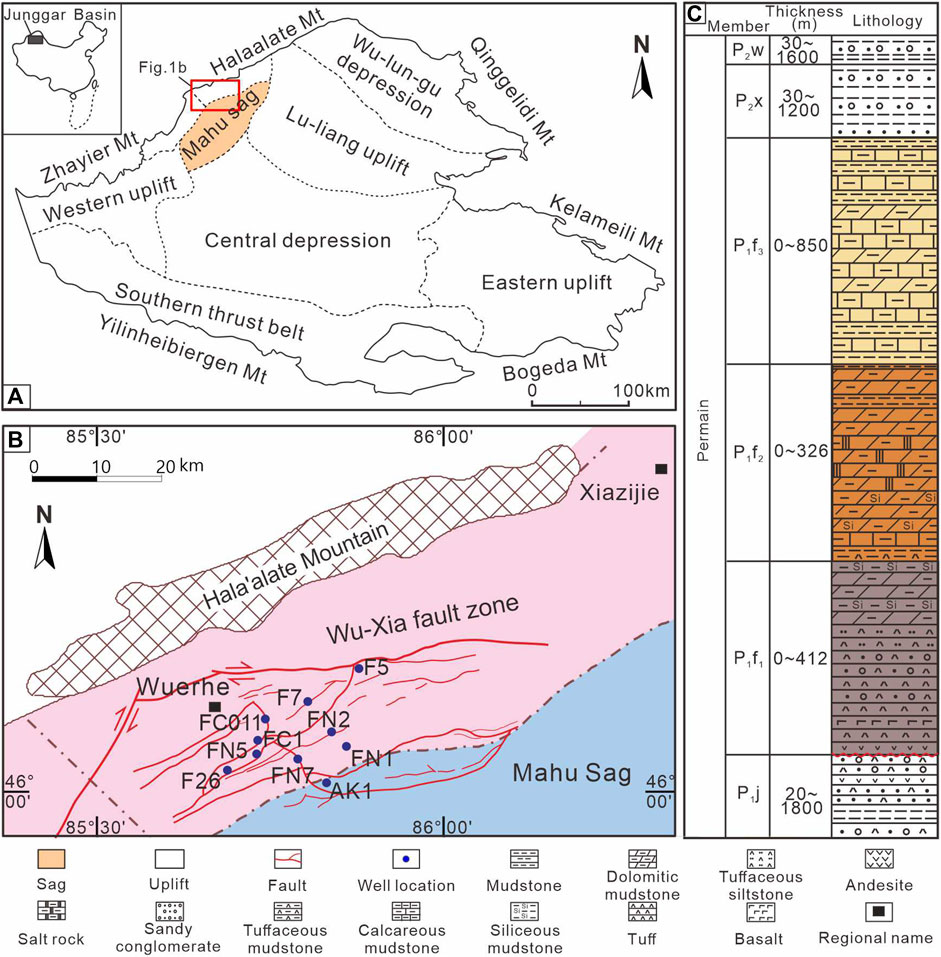
FIGURE 1. Comprehensive geological map of the study area. (A) Regional division map of the Junggar Basin. (B) Location map of the northern Mahu Sag study area and distribution of faults. (C) Stratigraphic profile of the Fengcheng Formation in the Mahu Sag. P1j = Jiamuhe Formation, P1f1 = the Lower Member, P1f2 = the Middle Member, P1f3 = Upper Member, P2x = Xiazijie Formation, P2w = Wuerhe Formation.
The lacustrine facies of the Fengcheng Formation in the Lower Permian are considered the oldest known alkaline lacustrine deposits discovered in China to date, and they are recognized as high-quality hydrocarbon source rocks (Cao et al., 2015; Cao et al., 2020). These sediments form an important foundation for the extensive oilfield in the northwest margin of the Junggar Basin. The Fengcheng Formation is abundant in oil and gas resources, with developed source and reservoir beds, characterized by self-generated and self-reservoired properties (Kuang et al., 2012; Lei et al., 2017). The sedimentary rock composition is complex, with thin and interbedded layers exhibiting strong rhythmicity, and is considered a new type of lacustrine shale oil reservoir (Zhi et al., 2019; Tang Y. et al., 2021c), possessing significant potential for shale oil production. The distribution range of shale oil reservoirs in the Mahu Sag is controlled by high-quality source rocks with alkaline lacustrine deposits, which forms the foundation of the entire oil and gas system in the Mahu Sag.
The formation of alkaline lacustrine source rocks in the Fengcheng Formation of the Mahu Sag is believed to have occurred in a high-salinity, closed-basin lacustrine environment influenced by deep-seated hydrothermal and volcanic activities. This environment is characterized by abundant alkaline minerals and exhibits complex and variable lithology and mineral composition (Zhang Y. et al., 2018). Based on different lithofacies combinations and sedimentary environments, the Fengcheng Formation is classified into three units from bottom to top: Lower Member (P1f1), Middle Member (P1f2), and Upper Member (P1f3) (Figure 1C). The lower part of the Lower Member (P1f1) is predominantly composed of coarse clastic rocks, organic-rich mudstones, interbedded dolomitic mudstones, intermediate to mafic volcanic rocks, tuffaceous rocks, and welded tuff rocks, whereas the upper part is mainly composed of organic-rich mudstones and tuffaceous interbeds. The Middle Member (P1f2) is mainly composed of organic-rich shale, mudstone, dolomitic mudstone, and siltstone, with abundant alkaline minerals present, such as wegscheiderite, shortite, eitelite, northupite, reedmergnerite, and searlesite (Zhang Y. et al., 2018). The lower part of the Upper Member (P1f3) is dominated by mudstones and interbedded dolomitic mudstones, while the upper part is characterized by terrigenous clastic sedimentary rocks. Extensive geochemical studies indicate that the paleoclimatic conditions of the Lower Member shifted from semi-arid to humid, while the Middle Member transitioned from humid to arid, and the Upper Member reverted back to a semi-arid climate (Cao et al., 2015; Zhang Z. et al., 2018).
Based on observations and descriptions of core samples from 10 wells in the study area (Figures 2A–F), we selected 80 samples from the Permian Fengcheng Formation for organic matter and related analyses.
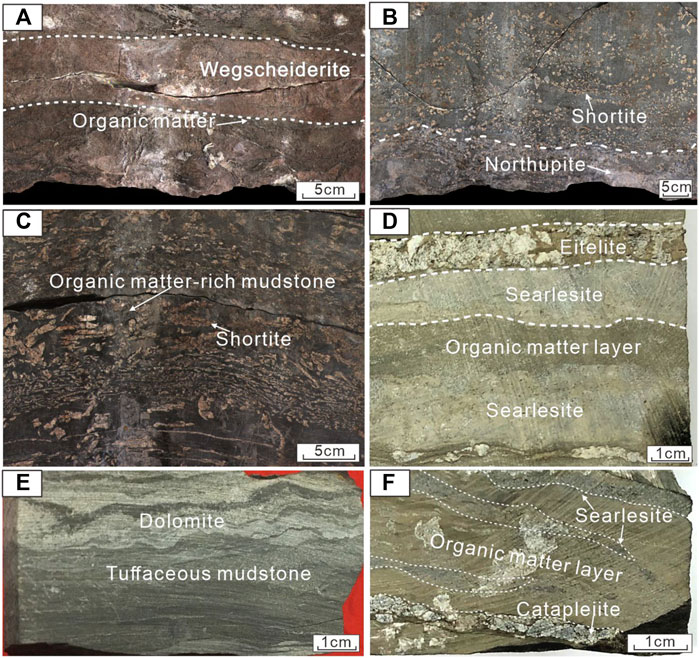
FIGURE 2. Photographs of core samples. (A) The top and bottom parts of the wegscheiderite bearing layer are mudstones, with a high organic content in the transition layer. The wegscheiderite content in the mudstone layer is low, dominated by shortite and northupite, well FN5, P1f2. (B) The upper mudstone layer is mainly composed of shortite, while the lower layers have an increased content of northupite and reedmergnerite, well FN5, P1f2. (C) Shortite in hand specimens exhibits various shapes, and there is a substantial amount of special organic matter developed in the mudstone matrix, well FN5, P1f2. (D) White eitelite and searlesite occur in layered distribution, and there are clusters of searlesite in the brown-yellowish-white dolomitic mudstone below, which is rich in organic matter, well F26, P1f3. (E) Deposition of tuffaceous and dolomitic mudstone, well F26, P1f3. (F) A significant amount of organic matter with yellow-green color is developed in the dolomitic mudstone, and alkaline mineral searlesite clusters and characteristic mineral catapleite are also developed, well F26, P1f3.
First, the samples were cut into blocks of suitable size, and the cut samples were subjected to multiple polishing processes to obtain regular thin sections (30 μm) and probe sections (35–40 μm) for optical observation, and specific polished thin sections for fluorescence. The remaining samples were ground to approximately 200 mesh using an agate mortar and pestle for whole-rock mineral analysis using X-ray diffraction, measurement of TOC content, and rock pyrolysis experiments.
Initially, the minerals in the thin sections were preliminarily identified under a microscope. Then, 80 powder samples containing various types of minerals were selected for X-ray diffraction (XRD) analysis. The samples were analyzed using a D8 Advance X-ray diffractometer with an incident slit width of 0.3 mm and a detector slit width of 8 mm. The scanning angle (2θ) was set from 4.5° to 50° with a step size of 0.02° and a scanning time of 0.5 s per step. Data processing was carried out using Jade 6.5 software.
The TOC and rock pyrolysis analyses were conducted on 80 samples. The 200-mesh powder samples were soaked in diluted HCl (5%) for 24 h, centrifuged, dried to remove inorganic carbon, and then continuously washed with distilled water until neutral. The samples were analyzed using a LECO CS-230 C–S analyzer. The milled samples were subjected to rock pyrolysis analysis using a Rock-Eval six pyrolysis instrument, and the main test results included S1 (free hydrocarbons), S2 (pyrolyzed hydrocarbons), and Tmax, which represents the maximum heating temperature at the peak of S2. Finally, the hydrogen index (HI) was calculated using the formula HI = S2/TOC × 100, and the oxygen index (OI) was calculated as OI = S3/TOC × 100.
A Nikon E200 microscope with a ×50 oil-immersion objective lens was used to conduct reflectance and fluorescence microscopic observations on 75 fluorescence slides, following the methods described by Taylor et al. (1998). The types of organic matter were determined based on the morphology, reflectance, and fluorescence colors of the organic material, following the classification scheme provided by ICCP (1994, 1998, and 2001), as outlined by Pickel et al. (2017).
The selected thin sections and bulk samples were observed, imaged, and analyzed using a FEI Quanta 650 FEG field-emission scanning electron microscope equipped with an Oxford INCA X-MAX50 250+ X-ray energy-dispersive spectrometer. The acceleration voltage was set at 15–20 kV, the beam current was 5 nA, and the working distance was approximately 10 mm.
Based on the lithological characteristics observed from drilling core samples and thin section analysis, it is evident that the northern part of the Mahu Sag is characterized by the presence of abundant alkaline minerals, including laminar, thinly laminar, spotted, cloud-like, and pure alkali layers. Based on lithofacies and mineralogical analysis, the alkaline minerals in the Fengcheng Formation of the Mahu Sag can be classified into four categories: sodium carbonate, sodium silicate, characteristic, and common minerals. The sodium carbonate minerals mainly include shortite (Na2Ca2(CO3)3), wegscheiderite (Na2CO3·3NaHCO3), northupite (Na3Mg(CO3)2Cl), and eitelite (Na2Mg(CO3)2). Wegscheiderite occurs as thick layers ranging from several centimeters to tens of centimeters (Figures 2A, 3A), and is often associated with low quantities of nahcolite, trona, and other minerals. Shortite is primarily distributed in the Lower and Middle members, occurring as banded or massive aggregates in mudstones, some of which are intergrown with spotted northupite crystals (Figure 3F). Eitelite is mainly distributed in the transitional zone between the pure alkaline layer (wegscheiderite layer) and mud layers, mostly occurring in layers with a thickness of 0.1–5 cm (as shown in Figure 3E). Moreover, a low quantity of eitelite crystals also occurs in a subhedral to anhedral distribution in layers enriched with wegscheiderite. Sodium borosilicate minerals refer to sodium-rich silicate minerals that form in alkaline lacustrine environments, primarily distributed along the margin of the Mahu Slope near the Wuxia Fault Belt. These minerals are often associated with sodium carbonate minerals, and include reedmergnerite, searlesite, and leucosphenite. In the mudstone interbeds with dolomitic mudstone, reedmergnerite and searlesite coexist, forming horizontal laminations, vein-like bodies, and lenses (Figures 3B–D, G, H). The characteristic minerals in these deposits include relatively minor quantities of burbankite, catapleiite, leucosphenite, and aegirine. Common minerals include dolomite, ankerite, and pyrite. Dolomite and ankerite are widely distributed, occurring in the slope and sag areas of the Fengcheng region. The morphology of dolomite and ankerite in the Fengcheng Formation can be categorized as rosette-like, spotted aggregates, and euhedral grains (Figure 3D). Framboids pyrite and layered pyrite at the bottom of the wegscheiderite layer are also observed in the core samples, as well as coarse-grained euhedral pyrite occurring in reedmergnerite or quartz veins.
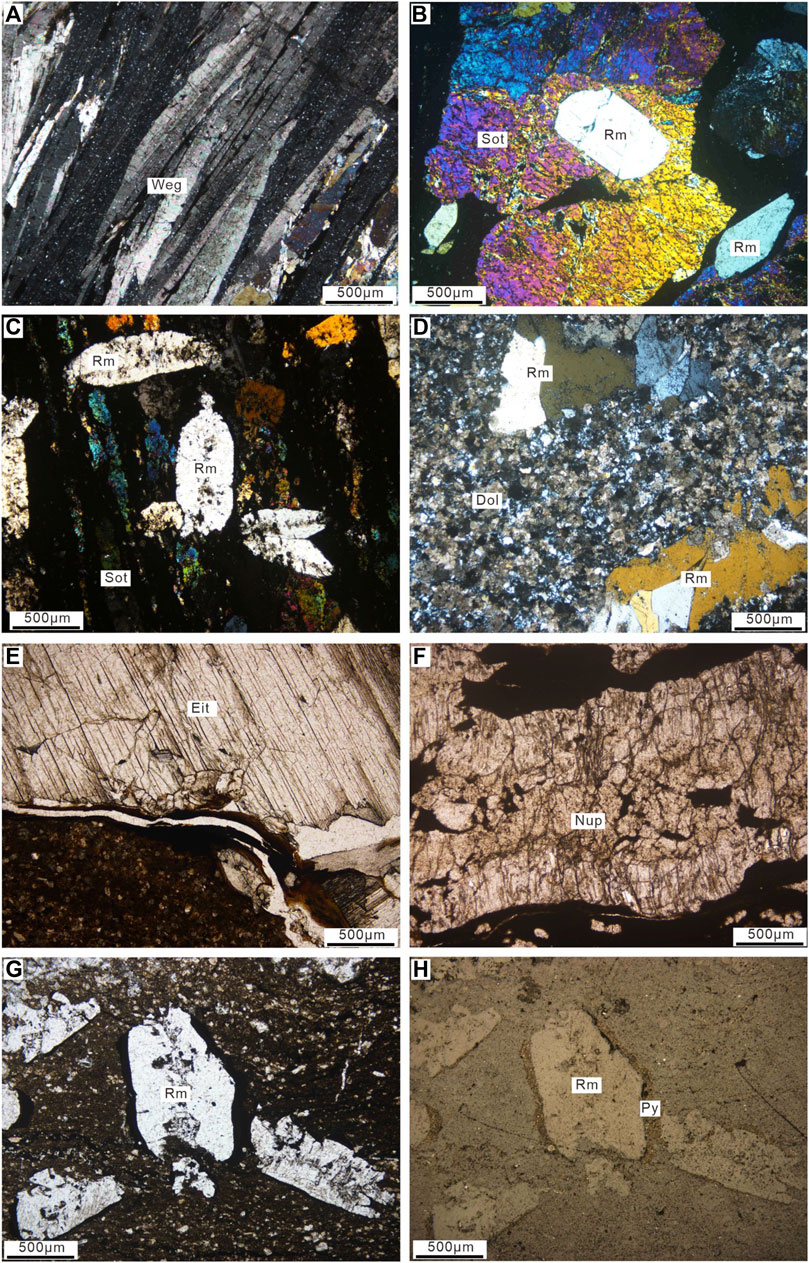
FIGURE 3. (A) Columnar crystals of wegscheiderite in a pure alkali layer, which appear colorless and exhibit high-grade white interference color under cross-polarized light, well FN5, P1f2. (B) In the alkaline mineral-rich mudstone, the anhedral shortite contains euhedral reedmergnerite, as observed under cross-polarized light, well FN7, P1f2. (C) Reedmergnerite cross-cuts the shortite, as observed under cross-polarized light, well AK1, P1f1. (D) Anhedral reedmergnerite crystals are developed in the dolomitic mudstone, as observed under cross-polarized light, well FN1, P1f1. (E) Vein-like crystals of eitelite are present in the dolomitic mudstone, as observed under plane-polarized light, well F26, P1f3. (F) Aggregates of anhedral northupite crystals are found in the alkaline mineral-rich mudstone, as observed under plane-polarized light, well FN5, P1f2. (G) and (H) Fine-grained pyrite is accumulated around the subhedral reedmergnerite crystals in the dolomitic mudstone, with (G) observed under plane-polarized light and (H) observed under reflected light, well FN2, P1f2. Abbreviations: Weg, Wegscheiderite, Sot, Shortite, Rm, Reedmergnerite, Dol, Dolomite, Eit, Eitelite, Nup, Northupite, Py, Pyrite.
Based on observations from thin sections, scanning electron microscopy (SEM), energy-dispersive X-ray spectroscopy (EDS) data, and XRD analysis, the distribution of alkaline minerals and common minerals in the Fengcheng Formation exhibits a clear and systematic pattern. Based on the mineral assemblages observed on the plane, the alkaline lacustrine deposits of the Fengcheng Formation can be classified into three zones: 1) inner zone, 2) transitional zone, and 3) marginal zone. The inner zone is located in the center of the sag, with major well locations such as AK1, FN5, and FN7 (with the lithologic column of well FN5 shown in Figure 4). Based on results of the XRD analysis, the inner zone is characterized by the presence of sodium carbonate minerals (the sodium carbonate content is up to 79%), with the mineral assemblage dominated by wegscheiderite and shortite. Meanwhile, common minerals such as calcite and dolomite are not well developed in the inner zone. The transitional zone is characterized by a mineral assemblage of sodium borosilicate minerals, including reedmergnerite and searlesite, with significantly higher content than the inner and marginal zones (the sodium borosilicate content is up to 49%). Additionally, calcite and dolomite start to appear in the transitional zone, with dolomite being more abundant than calcite. Wells F26, FN2, FC011, FN1, and FN4 are located within the transitional zone (Figure 4). In the marginal zone, there is a significant increase in the abundance of calcite, which is much higher than in the inner and transitional zones (the content of calcite is up to 27%). At the same time, sodium carbonate minerals are largely absent in the marginal zone and the content of reedmergnerite and searlesite is very small. Wells F5, F7, and MY1 are located in the marginal zone. There is a regular variation in mineral content from the inner zone to the marginal zone, with a gradual decrease in sodium carbonate minerals from the center to the margin. The highest contents of reedmergnerite and searlesite are observed in the transitional zone, while calcite is absent in the inner zone and reaches its highest content in the marginal zone. The content of felsic minerals is positively correlated with the abundance of clastic rocks in sedimentary rocks such as mudstone and dolomitic mudstone, which exhibit a decrease in mineral content from the inner zone to the marginal zone (Figure 5A). Therefore, the plane distribution of the Fengcheng Formation can be classified into three zones based on changes in mineral composition. At the same time, clay mineral content also exhibits a certain distribution pattern. From the inner zone to the marginal zone, the content of illite–smectite mixed layers increases while the content of illite decreases (Figure 5B). In the inner zone, the content of illite is the highest, with some samples reaching 100%.
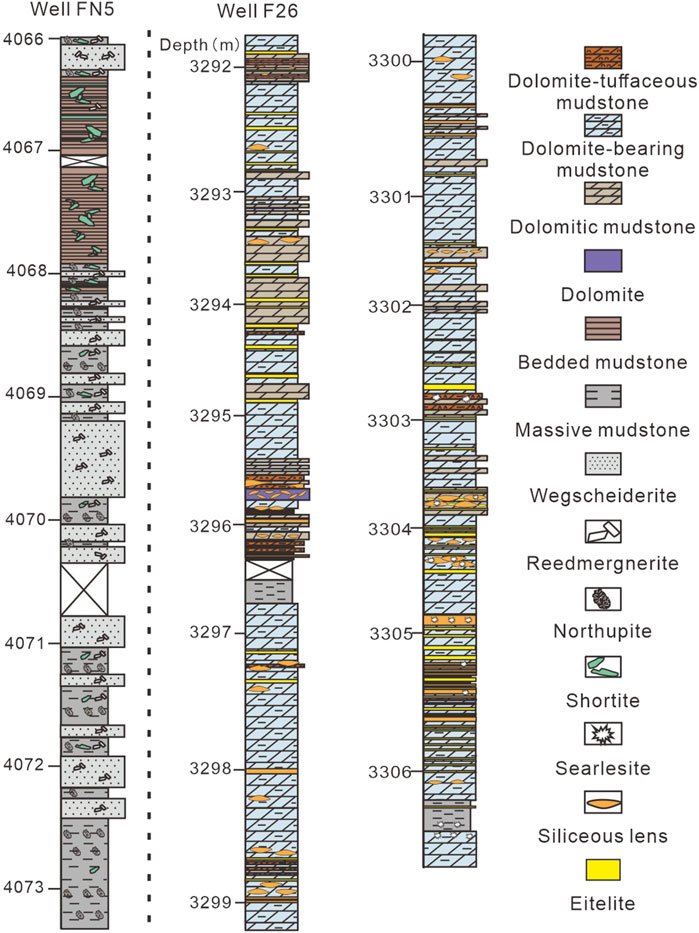
FIGURE 4. Lithological columnar diagrams for wells FN5 and F26 (well locations shown in Figure 1).
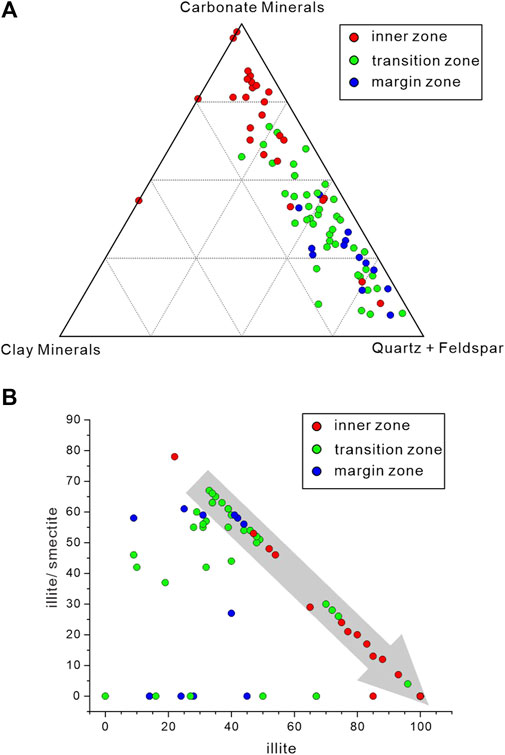
FIGURE 5. (A) Classification of mineral species using the triangular diagram in the Fengcheng Formation. (B) Correlation between illite and illite-smectite layers in the clay minerals of the Fengcheng Formation.
Based on the results summarized from previous studies (Chen et al., 2016; Gao et al., 2018; Xiao et al., 2021; He et al., 2022; Hou et al., 2022), the TOC content of the source rocks in the Fengcheng Formation ranges from 0.03% to 4.17%, with an average of 0.96%. The S1+S2 values of the source rocks range from 0.15 mg/g to 29.56 mg/g, with an average of 5.63 mg/g. Overall, the source rock samples from the Fengcheng Formation exhibit characteristics of high organic matter abundance (TOC >1.0%) and high hydrocarbon generation potential (S1+S2 > 6.0 mg/g) (Figure 6A). Most of the samples are classified as moderate to high-quality source rocks. High-quality source rocks constitute 40% and are characterized by a predominance of sapropelic type organic matter, indicating a high hydrocarbon generation potential. Results of the classification of kerogen types based on the Van Krevelen diagram indicate that the dominant kerogen types in the shale of the Fengcheng Formation are type II2 and type II1(Welte and Tissot, 1984), with minor occurrences of type I and type III kerogens (Figure 6B). Among these, type I and type II1 kerogens exhibit the highest oil-prone characteristics and have relatively high residual hydrocarbon generation potential in the shale. The organic matter of the Fengcheng Formation shale sample in the study area is generally in the low maturity to mature stage (Figure 6B), with Ro range of 0.56%–1.14% and an average of 0.80%. This indicates that the organic matter has reached the mature stage. In summary, the shale of the Fengcheng Formation is a good quality source rock, with high organic matter abundance, favorable oil generation potential, and overall maturity.
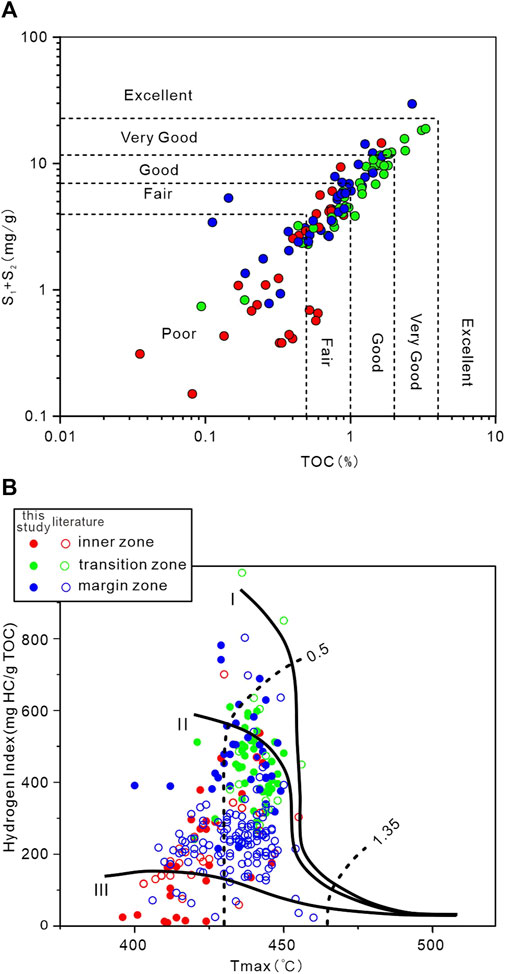
FIGURE 6. (A) Correlation between TOC content and hydrocarbon generation potential in the shale of the Fengcheng Formation. The base map is based on studies by Mukhopadhyay et al. (1995) and Peters et al. (1994). (B) Classification of organic matter types in the Fengcheng Formation. (Data are sourced from Chen et al., 2016; Gao et al., 2018; He et al., 2022; Xiao et al., 2021).
A large number of organic matters, including bacteria, algae and higher plants, were observed in the alkaline lacustrine deposits of the Fengcheng Formation. Bacteria, mainly spherical microorganisms, are seldomly observed in the marginal zone, and not discussed in this study. Algae contain both telalginite and lamalginite, which developed throughout the entire region. Most higher plants are distributed in the marginal zone in the form of inertinites.
The organic matter in the inner zone of the Fengcheng Formation is primarily composed of algal material, including well-preserved telalginite and lamalginite algal (Figure 7). These exhibit typical yellow and yellow-green fluorescence. Because the wegscheiderite layer in the inner zone is interbedded with mudstone layers, where shortite, eitelite, and northupite are developed, and reedmergnerite is developed throughout (FN5 in Figure 4). Under microscopic observation, organic matter is rarely present in the wegscheiderite layer. In the transition layer between the wegscheiderite layer and the mudstone layer, a large number of lamalginites are developed, which undergo deformation due to the later compression of reedmergnerite (Figure 7A). Specific morphological telalginites are also developed in the shortite of the mudstone layer (Figures 7B, C), with a diameter of approximately 50–100 µm. Telalginite is found in muddy rocks coexisting with northupite and shortite (Figures 7D, E). Well-preserved yellow-green fluorescent telalginites are also found in reedmergnerite crystals (Figures 7F, G).
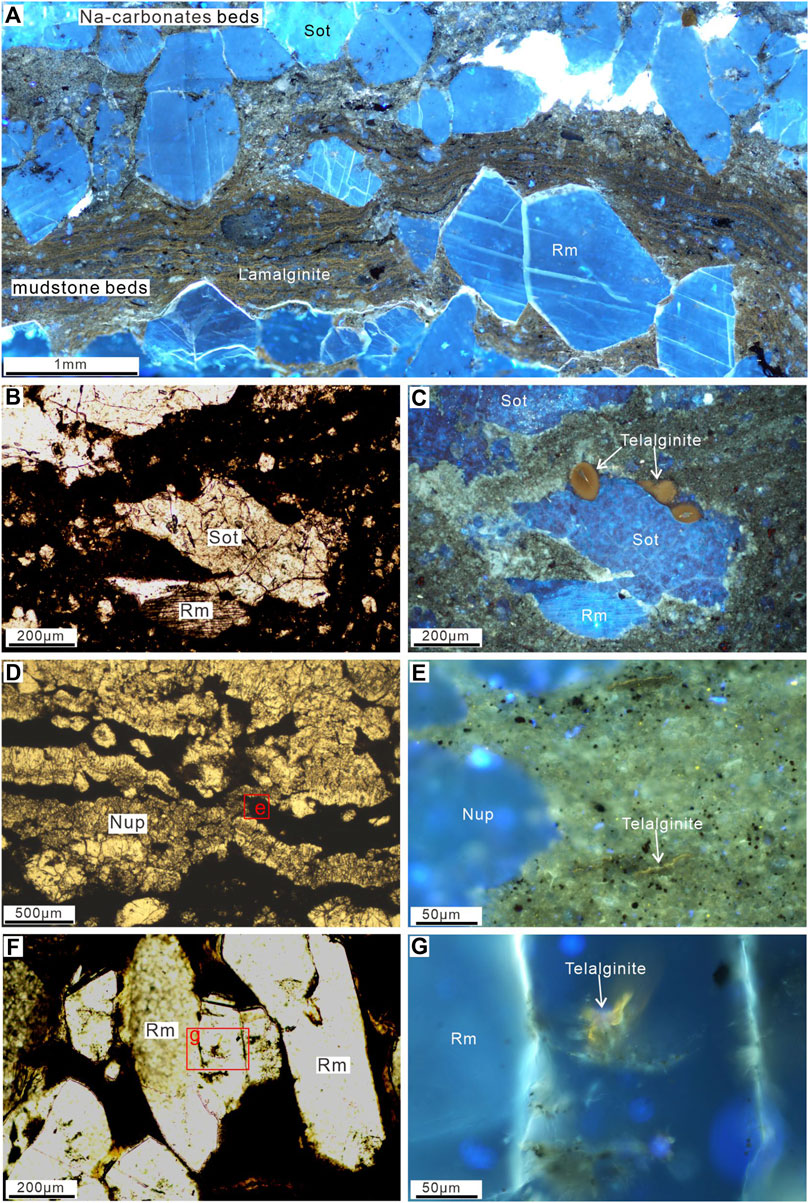
FIGURE 7. Microscopic photographs of organic matter in the inner zone. (A) The transition layer between the wegscheiderite and mudstone layers shows abundant lamalginite, which have been compressed by later-stage reedmergnerite minerals. Observed under fluorescence microscopy. (B) and (C) Specific types of telalginite coexisting with shortite minerals in mudstone. (B) Plane-polarized light, (C) Fluorescence microscopy. (D) Northupite minerals develop in the mudstone layer, with telalginite preserved between the minerals. (E) Enlarged view of the telalginite preserved in the mudstone layer, shown in (D). Displayed in orange-yellow color. Observed under fluorescence microscopy. (F) Well-preserved telalginite in the searlesite in dolomitic mudstone. Plane-polarized light microscopy. (G) Enlarged view of the telalginite shown in (F) under fluorescence microscopy. Nup, Northupite; Sot, Shortite; Rm, Reedmergnerite.
The lithology of the transitional zone in the Fengcheng Formation is complex. The main lithologies identified include dolomitic tuffaceous mudstones and dolomite-bearing mudstone. Reedmergnerite and searlesite are abundantly developed, while secondary minerals such as shortite, northupite, and eitelite are also present, with scarce occurrence of wegscheiderite (as shown in Figure 4, FN26). Abundant lamalginites are also observed in the dolomitic mudstone of the transitional zone (Figure 8A), exhibiting yellow-green fluorescence under the microscope. Telalginites are also present in the muddy matrix between dolomite grains (Figure 8G). In the dolomite containing tuffaceous mudstone, both telalginite and lamalginite are extensively developed (Figures 8B, C, E), with some forming clustered aggregates (Figure 8F). The transitional zone is characterized by the symbolic mineral, reedmergnerite, which shows a certain distribution relationship with organic matter. Well-preserved telalginites are found in the nodules of searlesite (Figure 8D). Residual telalginites are also observed in the vein-like fractures of reedmergnerite, exhibiting strong deformation due to compression. Aggregates of telalginite and fine-grained sedimentary pyrite are observed on the edge of poorly crystallized reedmergnerite.
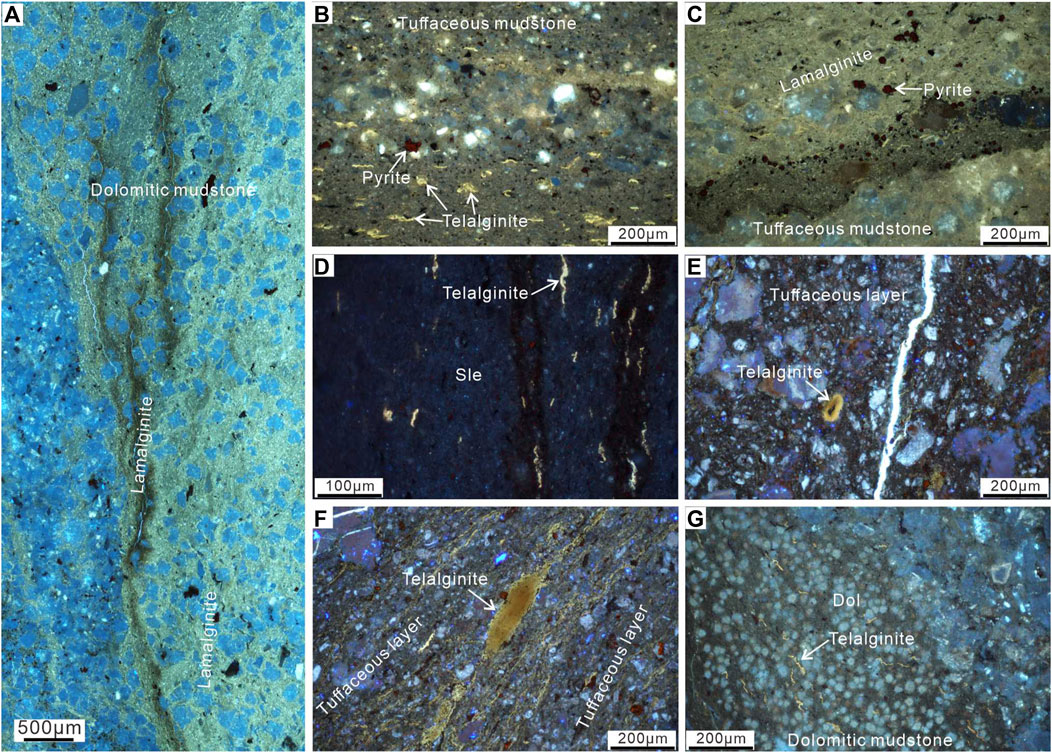
FIGURE 8. Microscopic photographs of organic matter in the transitional zone. (A) Lamalginite in dolomitic mudstones. Observed under fluorescence microscopy. (B) Abundant development of telalginite in tuffaceous layers. Observed under fluorescence microscopy. (C) Lamalginite preserved in tuffaceous mudstone. (D) Well-preserved telalginite in searlesite. Observed under fluorescence microscopy. (E) Telalginite in tuffaceous layers, observed under fluorescence microscopy. (F) Agglomerated telalginite in tuffaceous layers, observed under fluorescence microscopy. (G) Telalginite in the matrix surrounding dolomite. Observed under fluorescence microscopy. Dol, Dolomite; Rm =, Reedmergnerite; Sle, Searlesite.
The marginal zone of the Fengcheng Formation has a relatively low total organic carbon content, and telalginite are a major component of the bio-precursor. Abundant, well-preserved telalginite are developed in the mudstone layers, showing intact structures (Figures 9A, C, E), and exhibiting deformation due to compression (Figure 9A). The fluorescence color of the telalginite is relatively dark, appearing orange-red under fluorescence microscopy (Figures 9C–E). In addition, numerous inertinite macerals can be identified (Figures 9B, F). Similar to the vitrinite group, the inertinite group in shale is present in the form of dispersed particles within the mineral matrix (Figure 9B). Cell structures can be preserved in the maceral components of the fusinite and semifusinite groups.
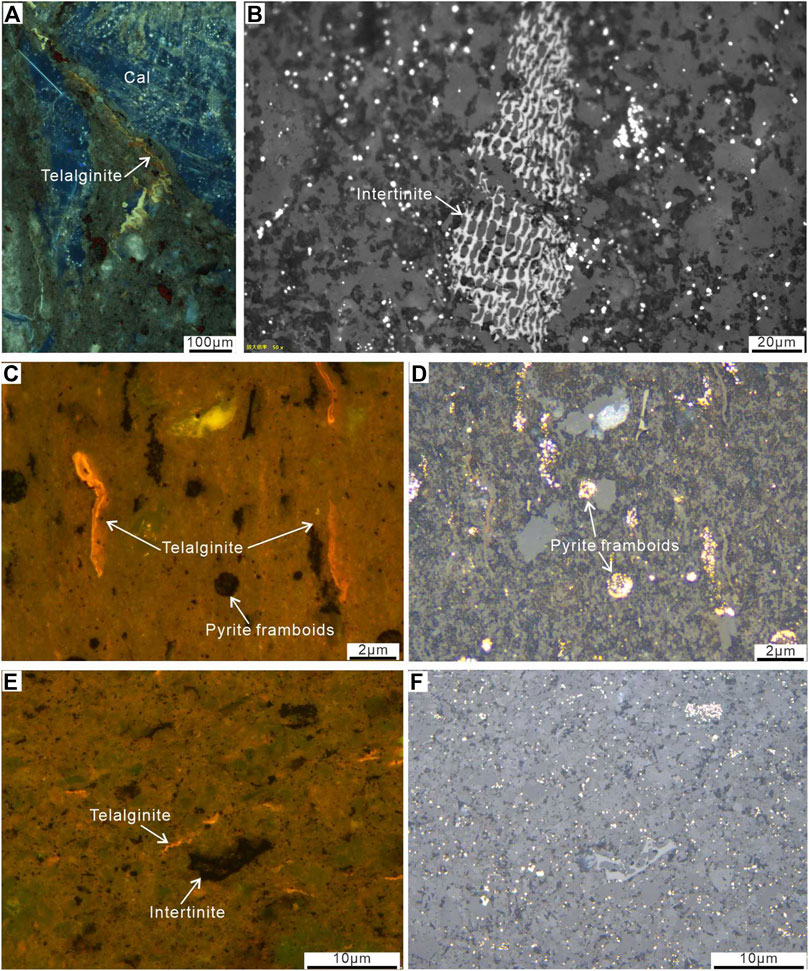
FIGURE 9. Microscopic photographs of organic matter in the margin zone. (A) Telalginite developed in mudstone surrounding calcite, deformed due to compression. Observed under fluorescence microscopy. (B) Well-preserved inertinite distributed in the clastic matrix, observed under reflected light microscopy. (C) and (D) Co-occurrence of distinctively shaped telalginite and framboids pyrite. (C) Observed under fluorescence microscopy, (D) observed under reflected light microscopy. (E) and (F) Co-occurrence of telalginite and inertinite. (E) Observed under fluorescence microscopy, (F) observed under reflected light microscopy. Cal, Calcite.
The distribution of alkaline lacustrine source rocks in the Mahu Sag of the Fengcheng Formation is stable, with a cumulative thickness exceeding 200 m, providing a solid material basis for hydrocarbon generation (Zhi et al., 2016; Bai et al., 2022). The abundance of organic matter of the source rocks is mainly evaluated through parameters such as TOC, petroleum generation potential (PG = S1 + S2), and HI in rock pyrolysis (Welte and Tissot, 1984; Peters, 1986). Based on results of previous studies on mineral zoning, we also conducted zone-specific analysis of organic geochemical data. Results from the marginal zone show that the TOC content of the source rocks ranges from 0.11% to 2.67%, with an average of 1.16%, predominantly composed of type II2 kerogen. In the transitional zone, the TOC content varies from 0.09% to 3.30%, with an average of 1.89%, dominated by types I and II1 kerogens. The inner zone exhibits a TOC content ranging from 0.03% to 1.64%, with an average of 0.76%. Types II1 and I kerogens are mainly oil-prone, and during the mature stage, the generated gas is predominantly of the oil type gas (Figure 6B).
As mentioned earlier, the sedimentation in alkaline lake is influenced by climate changes characterized by alternating cold-dry and warm-wet periods, resulting in fluctuations in lacustrine water salinity. The interbedding of evaporite rocks such as dolomite and trona with organic-rich mudstones (oil shales) during wet periods (Figure 4), reflecting seasonal fluctuations in lacustrine water levels and salinity changes. During humid periods, there is a significant proliferation of algal organisms that develop into algal mats (Namsaraev et al., 2018). These mats can become buried and lithified, eventually forming an important constituent of source rocks known as kerogen. Mudstones and other clastic rocks are primarily composed of felsic minerals, and significant bio-precursor such as algae are mainly developed within these rocks. The previous analysis revealed a positive correlation between TOC content and abundance of felsic minerals. However, the presence of sodium carbonate minerals has a negative impact on TOC content, indicating that organic matter development is not significant in environments with high alkalinity (Figure 10A). Therefore, in this study, we have excluded the content of sodium carbonate minerals in the samples to investigate the correlation between organic matter and lithological components outside the sodium carbonate mineral (Figure 11). The specific calculation of total organic carbon normalization (TOCn) is based on the results of XRD data. The original whole rock organic carbon content is divided by the content of residual minerals excluding sodium carbonates. Normalization results show that the TOCn content is higher in the inner and transitional zones than in the marginal zone. Therefore, we can conclude that during the intermittent period of evaporite mineral deposition, which corresponds to a relatively wet period, a high quantity of organic matter was deposited in the inner and transitional zones of the alkaline lacustrine deposits in the Fengcheng Formation. This depositional environment was more conducive to the development of high-quality algae. The Green River Formation in the Piceance Basin during the Eocene Epoch is a typical deep lacustrine deposit, that is, rich in organic matter. It exhibits a mixed lacustrine sedimentary system with carbonate-siliceous and evaporitic facies, and the variation in organic matter abundance is primarily controlled by climate-induced changes in lacustrine water level during the Eocene Epoch (Tänavsuu-Milkeviciene and Frederick Sarg, 2012). During the lowstand phase, productivity was low, while during the highstand phase of rising lacustrine waters, the average organic abundance was higher. Simultaneously, weak freshwater inflow and high salinity in the Eocene Hetaoyuan Formation of the Biyang Sag promoted water column stratification, creating stable chemoclines and anoxic environments in the bottom water. The combination of relatively higher nutrient concentrations in saline water and abundant CO32− ions under alkaline conditions may have resulted in high primary productivity in the high-salinity lacustrine (Tan et al., 2019). In the Mahu Sag, the Fengcheng Formation is characterized by distinct lithofacies that represent different sedimentary environment patterns, including shallow lacustrine margin, slope, lacustrine center, and steep slope margin. Lacustrine level fluctuations have a significant impact on shallow saline lacustrine systems, resulting in complex sedimentary environments (Yu et al., 2019). In summary, the distribution of organic matter in the ancient alkaline lacustrine deposits of the Fengcheng Formation is controlled by the sedimentary environment of the waterbody. During the period of alkaline mineral development, evaporation of the lacustrine water is at its maximum, resulting in a shallow water depth. During the humid period, as the lacustrine water level rises, the inner zone of the lacustrine develops deep lacustrine facies sedimentation, with a mixture of alkaline minerals and clastic minerals. The relatively high productivity and reducing environment of the alkaline lacustrine deposits during this period result in the deposition of abundant organic matter in the Fengcheng Formation, similar to the observation of extensive algal mats and microbial communities in the alkaline lakes of East Africa (Grant and Jones, 2016).
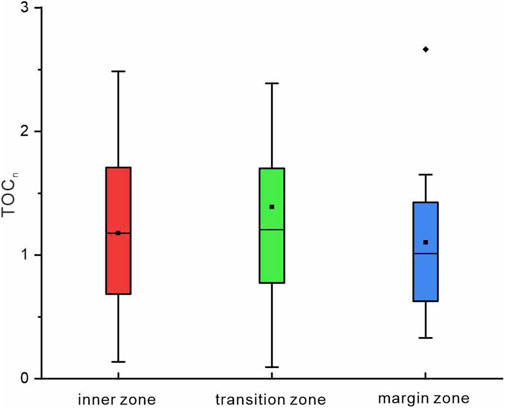
FIGURE 10. (A) Correlation between contents of sodium carbonate minerals and TOC. (B) Correlation between contents of felsic mineral and TOC.
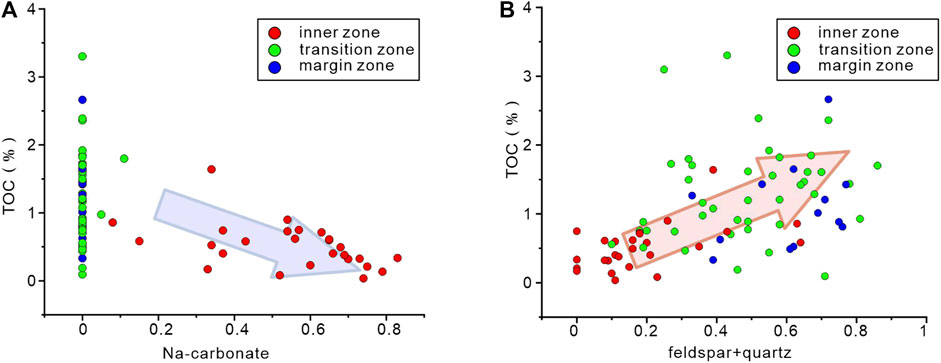
FIGURE 11. Box plot of normalized total organic carbon content (TOCn), after excluding the contribution of sodium carbonate minerals.
As hydrologic closure is one of the necessary conditions for the formation of alkaline lacustrine deposits, the evolution process involving the evaporation and concentration of alkaline lacustrine water is controlled by the composition of inflowing water ions in a closed hydrological system. The hydrological characteristics of alkaline lacustrine deposits and the precipitation of sodium carbonate in alkaline lacustrine deposits both indicate that the evolution path of alkaline lacustrine water is characterized by initial higher concentrations of bicarbonate ions compared to calcium and magnesium ions. As the lacustrine water continues to get concentrated, calcium and magnesium ions will preferentially precipitate, leading to the formation of calcite, dolomite, and magnesite in the mudflats at the margins of the lacustrine. As the evaporation and concentration of water increases, saline groundwater infiltrates into the central of the lacustrine basin, and sodium-calcium carbonate minerals precipitate in the pores. Eventually, the lacustrine water further concentrates into salt pans and naturally occurring alkaline minerals, such as sodium carbonate minerals (Hardie and Eugster, 1970). Therefore, the presence of alkaline minerals in alkaline lacustrine deposits can reflect changes in the sedimentary environment of the waterbody (Gärtner and Witkamp, 2007; Jagniecki et al., 2013; Jia et al., 2015; Yu et al., 2019; Getenet et al., 2023). Accordingly, the types of minerals found in different zones of the Fengcheng Formation can be used to infer changes in paleoenvironmental conditions within each respective zone. Previous research has revealed that the distribution of salinity and pH of the Fengcheng Formation in the Mahu Sag follows a certain pattern in the planar. Calculations based on indicators such as Z-values, Y/Ho ratios, oxygen isotopes, and nitrogen isotopes, which represent paleosalinity and paleo-pH values, have shown that pH decreases from the center to the margin, while salinity initially increases and then decreases (Yu et al., 2018a; Xia et al., 2020).
Previous analyses have shown that algae thrive in nutrient-rich brackish surface waters, which results from the mixing of fresh and salt waters (Goodarzi et al., 2022). Vertical variations in salinity are observed in the well FN5 in the inner zone of the Fengcheng Formation (Yu et al., 2018b). Abundant algal is found in the wegscheiderite layer with high pH and the transitional mud layers with high salinity, indicating that the lamalginite in the Fengcheng Formation developed extensively during the transition phase between evaporative and humid periods. The fluorescent color of the telalginite is darker, some displaying yellow to orange-red. In the inner zone of the Fengcheng Formation, at depths exceeding 4,000 m, which is considered a highly mature stage of hydrocarbon generation, the telalginite exhibit darker colors. This confirms that the inner zone is at a higher level of maturity, with significant hydrocarbon generation from the bio-precursor, while the lamalginite is well preserved due to protection by salt minerals (Cao et al., 2015). Compared to the inner zone, transitional zone has lower pH and higher salinity. Previous research has determined that the development of telalginite is associated with environments characterized by a relatively higher salinity than lamalginite, which is consistent with the distribution of organic matter in the Fengcheng Formation (Liu S. et al., 2022). This indicates that the type and distribution of organic matter in the Fengcheng Formation are influenced by the salinity and pH of the waterbody. The inertinite in the marginal zone is derived from terrestrial organic matter and exhibit minimal hydrocarbon generation potential, typically classified as type Ⅲ kerogen (Liu B. et al., 2022). Inertinite is believed to have originated from pre-sedimentation wildfires or oxidation events, and even in early stages of maturation, they exhibit high reflectance values.
Based on a comprehensive analysis of lithofacies mineralogy, organic geochemistry, and fluorescence microscopy observations in the Mahu Sag, the organic matter distribution in the source rocks of Fengcheng Formation exhibits distinct characteristics on the plane, which are influenced by various factors. The inner zone of the alkaline lacustrine deposit is characterized by abundant and diverse alkaline minerals, complex lithofacies, and interbedding of evaporite minerals and mud layers, indicating significant fluctuations in the lacustrine surface water level. In the inner zone of the alkaline lacustrine deposit, which experiences high evaporation during dry periods, a local environment with high pH is formed. This leads to the abundant precipitation and deposition of wegscheiderite, resulting in the formation of wegscheiderite layers. The wegscheiderite layers have very low TOC content and are largely devoid of lamalginite, with predominantly prokaryotic bacteria. Subsequently, during wet periods, the lacustrine water level gradually rises and the water depth increases. During the transitional period, abundant lamalginite develop which adapted to the high pH alkaline waterbody. This algal is similar to the algal mats that formed during the Eocene rapid environmental changes, as well as the algal mats found in the high TOC oil shales of the Green River Formation (Boucsein and Stein, 2009; Tänavsuu-Milkeviciene et al., 2017). In later stages, the lamalginite undergoes bending and deformation due to the crystallization of well-preserved reedmergnerite. Even in the mudstone layers with low content of wegscheiderite formed during the rising phase of waterbody, developed characteristic assemblages of alkaline minerals that indicate high pH values during the deposition period. Lamalginite is not well-developed in the muddy matrix, and instead, matured telalginite forms mainly (Figures 7B–G Figures 7B–G, 10E), accompanied by relatively high TOC content. During this period, the bottom of the deep lacustrine environment in the central sag is predominantly characterized by reducing conditions (Tang W. et al., 2021b), which contribute to the preservation of organic matter. Previous studies have suggested that upwelling of deep hydrothermal fluids along faults in the sag center may have provided nutrient elements for the development of organic matter (Wang et al., 2020).
The transitional zone mainly comprises dolomitic mudstone, mudstone, and dolomite bearing tuffaceous mudstone. The occurrence of characteristic alkaline minerals indicates that the waterbody is still in an alkaline environment, with a relatively higher salinity than in the inner zone, supporting the development of halophilic and alkaliphilic algal. Lamalginite and telalginite are abundant in the transitional zone (Figures 8, 10F). Petrological, organic, and inorganic geochemical analyses indicate that lamalginite develop in low salinity environments, while telalginite forms are associated with high salinity environments (Liu S. et al., 2022). The content of telalginite in the transitional zone of the Fengcheng Formation is significantly higher than that in the inner zone, reflecting higher salinity conditions during the depositional period. The presence of tuffaceous mudstone reflects the input of abundant nutrients from peripheral volcanism, which in turn promotes the bloom of algae. The relatively high salinity and alkalinity of the waterbody provide favorable conditions for the development of algae. Together with tuffaceous materials, they control the characteristics of high TOC content and high productivity in the transitional zone of the alkaline lacustrine deposit. The abundant occurrence of siliceous layers, such as searlesite and reedmergnerite, also plays a protective role in preserving organic matter, preventing later destruction.
In the marginal zone, the TOC is relatively lower than that in the inner and transitional zones, and the development of sodium carbonate alkaline minerals is limited, with only a low quantity of reedmergnerite present. The pH of the water in the marginal zone is lower, and the salinity is relatively low. Due to the proximity to the lacustrine margin, the sedimentary environment is disturbed by debris, which disrupts the reducing conditions for organic matter preservation, resulting in only the partial development of telalginite (Figures 9, 10C). However, near the source, abundant and well-preserved inertinite are found, providing a significant contribution to the sedimentation of the Fengcheng Formation. Despite this, in some well locations close to volcano, there is still a significant development of telalginite, likely due to the input of abundant nutrients from volcanic eruptions.
The Lower Permian source rocks of Fengcheng Formation are alkaline lacustrine deposition, characterized by abundant algal and bacteria and high hydrocarbon generation potential. The source rocks have entered the oil window and are generally in a mature to highly mature stage, containing oil and gas in different evolutionary stages of low mature, mature, and high mature. The thermal evolution of the Fengcheng Formation shale is positively correlated with burial depth, with the hydrocarbon generation threshold of depth ≥3,500 m or deeper (Zhi et al., 2016). Shales at burial depths exceeding 4,000 m are typically mature source rocks. In the central area of the Mahu Sag where burial depths exceed 5,000 m, the source rocks have reached a high level of maturity (Wang et al., 2018). Particularly noteworthy is the presence of a bimodal high-efficiency hydrocarbon generation model with peaks in both “maturity” and “high maturity” (Figure 12B), with a hydrocarbon generation potential nearly twice that of traditional lacustrine source rocks (Tang Y. et al., 2021a). In this study on the organic matter of source rocks in the Fengcheng Formation, it was found that the bio-precursor is mainly composed of lamalginite in the inner and transitional zones, as well as telalginite in the inner, transition, and marginal zones. Lamalginite source rock displays a much narrower distribution of activation energies than telalginite source rocks, which effectively narrows down the main stages of hydrocarbon generation (Figure 12A). In addition, the concentration of activation energy distribution in the high-value interval for lamalginite indicating the characteristics of the relatively lagging hydrocarbon generation of lamalginite (Liu et al., 2023). The hydrocarbon generation characteristics of different stages of algal are consistent with the bimodal hydrocarbon generation model of the Fengcheng Formation, indicating that both telalginite and lamalginite are the main bio-precursor in the alkaline lacustrine deposits rocks of the Fengcheng Formation. The inner zone of the sag in the alkaline and lacustrine sedimentary rocks of the Fengcheng Formation, buried to >4,000 m, preserves well-preserved lamalginite in the transitional layer of the core in the inner zone, protected by characteristic alkaline minerals, which have been preserved during the burial process. The telalginite in the mud layers exhibit a darker fluorescence color (Figure 7E), indicating a higher maturity. When the thermal maturity of the source rock reaches 1.05%, abundant hydrocarbons are generated, with an increase in illite content from illite–smectite layers. Previous analysis indicated that telalginite in oil shales can generate a significant quantity of hydrocarbons and organic acids under temperature conditions, and these organic acids promote the transformation of smectite to illite. This greatly enhances the catalytic activity of illite, resulting in an increased hydrocarbon generation rate (Xu et al., 2022). In the cores of the Fengcheng Formation, there is a negative correlation between illite content and illite–smectite (Figure 5B). The highest illite content is observed in the inner zone, indicating higher maturity than the transition and marginal zones. Overall, the source rock of the Fengcheng Formation in the Mahu Sag exhibit unique characteristics owing to its alkaline lacustrine deposition features. The findings of this study on the organic matter of the Fengcheng Formation in the Mahu Sag provide important insights and guidance for the effective evaluation of source rocks and the selection of exploration targets in shale oil reservoirs and sweet spots.
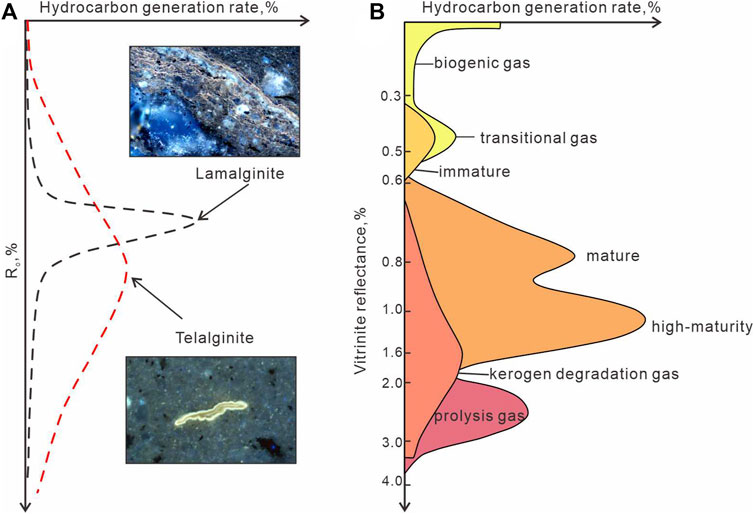
FIGURE 12. (A) Pattern of hydrocarbon generation in source rock rich in telalginite and lamalginite (Modified by Liu et al., 2023) (B) Bimodal high-efficiency hydrocarbon generation model in the Fengcheng Formation of the Mahu Sag (Modified by Tang Y. et al., 2021b).
(1) The distribution of alkaline minerals and common minerals in the Fengcheng Formation exhibits distinct patterns on a plane. Based on the characteristics of mineral assemblages, the alkaline lacustrine deposits of the Fengcheng Formation can be classified into three zones: the inner zone, transitional zone, and marginal zone. The inner zone is characterized by the dominant presence of sodium carbonate minerals, with a mineral assemblage consisting mainly of wegscheiderite and shortite. The transitional zone is characterized by a mineral assemblage of sodium borosilicate minerals, including reedmergnerite and searlesite, with significantly higher abundances than the inner and marginal zones.
(2) Organic geochemical data indicate that the source rocks of Fengcheng Formation in the Mahu Sag are generally moderate to high quality, with high TOC content and maturity ranging from mature to high mature. The inner zone exhibits a relatively high TOCn content after normalization, along with the presence of types II1 and I kerogen. In contrast, the marginal zone has a relatively lower TOC content than the inner zone and transitional zone, with type II2 kerogen being predominant.
(3) The transitional layer between the wegscheiderite layer and the alkaline mineral-rich mudstone layer in the inner zone of the Fengcheng Formation contains well-preserved lamalginite, and the telalginite with higher maturity developed in the muddy layer. The transitional zone develops telalginite that are more adaptable to high salinity. Transitional zoneAdditionally, the tuffaceous material in the transitional zone has provided abundant nutrient elements, promoting the bloom of lamalginite. The presence of searlesite has not only protected the organic matter from subsequent degradation, but also prevented further damage. In the marginal zone, the pH of the waterbody decreased, resulting in the limited development of telalginite, accompanied by the input of inertinite from terrestrial sources.
(4) The development and distribution of organic matter in different zones of the Fengcheng Formation in the Mahu Sag are controlled by multiple factors. In the inner zone, the alkaline-tolerant algal are primarily influenced by water depth and pH variations, with possible nutrient input from deep hydrothermal fluids. In the transitional zone, the organic matter is controlled by the combined effects of water salinity, pH, and allochthonous nutrient supply. In the marginal zone, the distribution of organic matter is mainly influenced by proximal sedimentary input, low pH, and low salinity of the depositional water. The distinct differences in hydrocarbon generation efficiency between telalginite and lamalginite source rocks are evident. Telalginite are capable of early hydrocarbon generation, aligning with the bimodal high-efficiency hydrocarbon generation model observed in the Fengcheng Formation of the Mahu Sag.
The original contributions presented in the study are included in the article/Supplementary Material, further inquiries can be directed to the corresponding author.
MN: writing—original draft, data processing. YZ: supervision, conceptualization; funding acquisition writing—review and editing. YT: resources. WH: resources. All authors contributed to the article and approved the submitted version.
This research is supported by Natural Science Foundation of China (NSFC) Project given to Zhaojie Guo (No. 42090021) and to ZY (42272157).
Authors TY and HW were employed by the company PetroChina Xinjiang Oilfield Company.
The remaining authors declare that the research was conducted in the absence of any commercial or financial relationships that could be construed as a potential conflict of interest.
All claims expressed in this article are solely those of the authors and do not necessarily represent those of their affiliated organizations, or those of the publisher, the editors and the reviewers. Any product that may be evaluated in this article, or claim that may be made by its manufacturer, is not guaranteed or endorsed by the publisher.
Bai, Y., Wang, F., Niu, Z., Jin, K., Li, P., Xu, D., et al. (2022). Hydrocarbon generation kinetics of source rocks of permian Fengcheng Formation in Mahu sag,Junggar Basin. Lithol. Reserv. 34, 116–127. doi:10.12108/yxyqc.20220411
Boucsein, B., and Stein, R. (2009). Black shale formation in the late Paleocene/early Eocene Arctic Ocean and paleoenvironmental conditions: New results from a detailed organic petrological study. Mar. Petroleum Geol. 26, 416–426. doi:10.1016/j.marpetgeo.2008.04.001
Cao, J., Lei, D., Li, Y., Tang, Y., AbulimitChang, Q., and Wang, T. (2015). Ancient high-quality alkaline lacustrine source rocks discovered in the lower permian Fengcheng Formation, Junggar Basin. Acta Pet. Sin. 36, 781–790.
Cao, J., Xia, L., Wang, T., Zhi, D., Tang, Y., and Li, W. (2020). An alkaline lake in the late paleozoic ice age (lpia): A review and new insights into paleoenvironment and petroleum geology. Earth-Science Rev. 202. doi:10.1016/j.earscirev.2020.103091
Chen, J.-F., Han, B.-F., Ji, J.-Q., Zhang, L., Xu, Z., He, G.-Q., et al. (2010). Zircon U–Pb ages and tectonic implications of paleozoic plutons in northern west junggar, north xinjiang, China. Lithos 115, 137–152. doi:10.1016/j.lithos.2009.11.014
Chen, Z., Liu, G., Wang, X., Gao, G., Xiang, B., Ren, J., et al. (2016). Origin and mixing of crude oils in Triassic reservoirs of Mahu slope area in Junggar Basin, NW China: Implication for control on oil distribution in basin having multiple source rocks. Mar. Petroleum Geol. 78, 373–389. doi:10.1016/j.marpetgeo.2016.09.022
Dyni, J. R. (2006). Geology and resources of some world oil-shale deposits. Reston, VA: USGS. doi:10.3133/sir29955294
Gao, G., Yang, S., Ren, J., Zhang, W., and Xiang, B. (2018). Geochemistry and depositional conditions of the carbonate-bearing lacustrine source rocks: A case study from the early permian Fengcheng Formation of well FN7 in the northwestern Junggar Basin. J. Petroleum Sci. Eng. 162, 407–418. doi:10.1016/j.petrol.2017.12.065
Gärtner, R. S., and Witkamp, G.-J. (2007). Mixed solvent reactive recrystallization of trona (sodium sesqui-carbonate) into soda (sodium carbonate anhydrate). Hydrometallurgy 88, 75–91. doi:10.1016/j.hydromet.2007.03.006
Getenet, M., Otálora, F., Emmerling, F., Al-Sabbagh, D., and García-Ruiz, J. M. (2023). Mineral precipitation and hydrochemical evolution through evaporitic processes in soda brines (East African Rift Valley). Chem. Geol. 616. doi:10.1016/j.chemgeo.2022.121222
Goodarzi, F., Hosseininejad, S., Pedersen, P. K., Gentzis, T., and Sanei, H. (2022). Characterization of immature oil shales from the cretaceous second white specks Formation in saskatchewan and manitoba, Canada. Mar. Petroleum Geol. 143. doi:10.1016/j.marpetgeo.2022.105774
Grant, W. D., and Jones, B. E. (2016). “Bacteria, archaea and viruses of soda lakes,” in Soda lakes of East Africa. Editor M. Schagerl (Cham: Springer International Publishing), 97–147.
Grant, W. D., Mwatha, W. E., and Jones, B. E. (1990). Alkaliphiles: Ecology, diversity and applications. FEMS Microbiol. Lett. 75, 255–269. doi:10.1016/0378-1097(90)90536-Y
Han, Y., and Zhao, G. (2018). Final amalgamation of the tianshan and junggar orogenic collage in the southwestern central asian orogenic belt: Constraints on the closure of the paleo-asian ocean. Earth-Science Rev. 186, 129–152. doi:10.1016/j.earscirev.2017.09.012
Han, B. F., Guo, Z. J., Zhang, Z. C., Zhang, L., Chen, J. F., and Song, B. (2010). Age, geochemistry, and tectonic implications of a late Paleozoic stitching pluton in the North Tian Shan suture zone, Western China. Geol. Soc. Am. Bull. 122, 627–640. doi:10.1130/b26491.1
Hardie, L. A., and Eugster, H. P. (1970). The evolution of closed basin brines. Mineral. Soc. Spec. Pap. 3, 273–290.
He, T., Lu, S., Li, W., Tan, Z., and Zhang, X. (2018). Effect of salinity on source rock Formation and its control on the oil content in shales in the Hetaoyuan Formation from the Biyang depression, Nanxiang Basin, central China. Energy fuels. 32, 6698–6707. doi:10.1021/acs.energyfuels.8b01075
He, W., Sun, Z., Qian, M., Yang, Z., Li, Z., Leng, J., et al. (2022). Evaluation of the oil-bearing properties of shale and shale oil mobility in the Fengcheng Formation in the Mahu sag, Junggar Basin, northwest China: A case study of well maye-1. Geofluids 2022, 1–16. doi:10.1155/2022/6206645
Helz, G. R., Bura-Nakić, E., Mikac, N., and Ciglenečki, I. (2011). New model for molybdenum behavior in euxinic waters. Chem. Geol. 284, 323–332. doi:10.1016/j.chemgeo.2011.03.012
Horsfield, B., Curry, D. J., Bohacs, K., Littke, R., Rullkötter, J., Schenk, H. J., et al. (1994). Organic geochemistry of freshwater and alkaline lacustrine sediments in the Green River Formation of the washakie basin, Wyoming, USA. Org. Geochem. 22, 415–440. doi:10.1016/0146-6380(94)90117-1
Hou, M., Qu, J., Zha, M., Swennen, R., Ding, X., Imin, A., et al. (2022). Significant contribution of haloalkaliphilic cyanobacteria to organic matter in an ancient alkaline lacustrine source rock: A case study from the permian Fengcheng Formation, Junggar Basin, China. Mar. Petroleum Geol. 138. doi:10.1016/j.marpetgeo.2022.105546
Jagniecki, E. A., Jenkins, D. M., Lowenstein, T. K., and Carroll, A. R. (2013). Experimental study of shortite (Na2Ca2(CO3)3) formation and application to the burial history of the wilkins peak member, Green River basin, Wyoming, USA. Geochim. Cosmochim. Acta 115, 31–45. doi:10.1016/j.gca.2013.04.005
Jia, B., Wen, H., Li, Y., Liu, Y., and Wang, T. (2015). Fluid inclusions in the salt minerals from the permian Fengcheng Formation in the urho region, Junggar Basin, xinjiang. Sediment. Geol. Tethyan Geol. 34, 33–42.
Katz, B. J. (1995). “The Green River shale: An Eocene carbonate lacustrine source rock,” in Petroleum source rocks. Editor B. J. Katz (Berlin, Heidelberg: Springer Berlin Heidelberg), 309–324.
Kuang, L., Tang, Y., Lei, D., Chang, Q., Ouyang, M., Hou, L., et al. (2012). Formation conditions and exploration potential of tight oil in the Permian saline lacustrine dolomitic rock, Junggar Basin, NW China. Petroleum Explor. Dev. 39, 700–711. doi:10.1016/s1876-3804(12)60095-0
Lei, D., Chen, G., Liu, H., Li, X., Tao, K., and Cao, J. (2017). Study on the forming conditions and exploration fields of the Mahu giant oil (gas) province, Junggar Basin. Acta Geol. Sin. 91, 1604–1619.
Li, C., Guo, P., Ke, X., and Ma, Y. (2021). Genesis of high-quality source rocks in volcano-related alkaline lakes and implications for the exploration and development of shale oil and gas. OIL GAS Geol. 42. doi:10.11743/ogg20210616
Liu, B., Mastalerz, M., and Schieber, J. (2022a). SEM petrography of dispersed organic matter in black shales: A review. Earth-Science Rev. 224. doi:10.1016/j.earscirev.2021.103874
Liu, S., Gao, G., Jin, J., Gang, W., and Xiang, B. (2022b). Source rock with high abundance of C28 regular sterane in typical brackish-saline lacustrine sediments: Biogenic source, depositional environment and hydrocarbon generation potential in Junggar Basin, China. J. Petroleum Sci. Eng. 208. doi:10.1016/j.petrol.2021.109670
Liu, S.-J., Gao, G., Gang, W.-Z., Xiang, B.-L., and Wang, M. (2023). Differences in geochemistry and hydrocarbon generation of source-rock samples dominated by telalginite and lamalginite: A case study on the permian saline lacustrine source rocks in the jimusaer sag, NW China. Petroleum Sci. 20, 141–160. doi:10.1016/j.petsci.2022.08.034
Mukhopadhyay, P. K., Wade, J. A., and Kruge, M. A. (1995). Organic facies and maturation of Jurassic/Cretaceous rocks, and possible oil-source rock correlation based on pyrolysis of asphaltenes, Scotian Basin, Canada. Org. Geochem. 22, 85–104. doi:10.1016/0146-6380(95)90010-1
Namsaraev, Z. B., Gorlenko, V. M., and Buryukhaev, S. P. (2018). Successional changes in the microbial community of the alkaline lake khilganta during the dry season. Microbiology 87, 591–596. doi:10.1134/s0026261718040124
Peters, K. E., Cassa, M. R., Magoon, L. B., and Dow, W. G. (1994). Applied source rock geochemistry, the petroleum system—From source to trap. American Association of Petroleum Geologists.
Peters, K. E. (1986). Guidelines for evaluating petroleum source rock using programmed Pyrolysis1. AAPG Bull. 70, 318–329. doi:10.1306/94885688-1704-11d7-8645000102c1865d
Pickel, W., Kus, J., Flores, D., Kalaitzidis, S., Christanis, K., Cardott, B. J., et al. (2017). Classification of liptinite – ICCP system 1994. Int. J. Coal Geol. 169, 40–61. doi:10.1016/j.coal.2016.11.004
Ruble, T. E., and Philp, R. P. (1998). Stratigraphy, depositional environments and organic geochemistry of source-rocks in the Green River petroleum system. Utah: Uinta Basin.
Ruble, T. E., Lewan, M. D., and Philp, R. P. (2001). New insights on the Green River petroleum system in the Uinta basin from hydrous pyrolysis experiments. AAPG Bull. 85, 1333–1371. doi:10.1306/8626cab9-173b-11d7-8645000102c1865d
Song, Y., Li, S., and Hu, S. (2019). Warm-humid paleoclimate control of salinized lacustrine organic-rich shale deposition in the Oligocene Hetaoyuan Formation of the Biyang Depression, East China. Int. J. Coal Geol. 202, 69–84. doi:10.1016/j.coal.2018.11.016
Sorokin, D. Y., Berben, T., Melton, E. D., Overmars, L., Vavourakis, C. D., and Muyzer, G. (2014). Microbial diversity and biogeochemical cycling in soda lakes. Extremophiles 18, 791–809. doi:10.1007/s00792-014-0670-9
Tan, Z., Lu, S., Li, W., Zhang, Y., He, T., Jia, W., et al. (2019). Climate-driven variations in the depositional environment and organic matter accumulation of lacustrine mudstones: Evidence from organic and inorganic geochemistry in the Biyang depression, Nanxiang Basin, China. Energy fuels. 33, 6946–6960. doi:10.1021/acs.energyfuels.9b00595
Tänavsuu-Milkeviciene, K., and Frederick Sarg, J. (2012). Evolution of an organic-rich lake basin - stratigraphy, climate and tectonics: Piceance Creek basin, Eocene Green River Formation. Sedimentology 59, 1735–1768. doi:10.1111/j.1365-3091.2012.01324.x
Tänavsuu-Milkeviciene, K., Sarg, J. F., and Bartov, Y. (2017). Depositional Cycles and Sequences In An Organic-Rich Lake Basin: Eocene Green River Formation, Lake Uinta, Colorado and Utah, U.S.A. J. Sediment. Res. 87, 210–229. doi:10.2110/jsr.2017.11
Tang, W., Zhang, Y., Pe-Piper, G., Piper, D. J. W., Guo, Z., and Li, W. (2020). Soft-sediment deformation structures in alkaline lake deposits of Lower Permian Fengcheng Formation, Junggar Basin, NW China: Implications for syn-sedimentary tectonic activity. Sediment. Geol. 406. doi:10.1016/j.sedgeo.2020.105719
Tang, W., Zhang, Y., Pe-Piper, G., Piper, D. J. W., Guo, Z., and Li, W. (2021a). Permian rifting processes in the NW Junggar Basin, China: Implications for the post-accretionary successor basins. Gondwana Res. 98, 107–124. doi:10.1016/j.gr.2021.06.005
Tang, W., Zhang, Y., Pe-Piper, G., Piper, D. J. W., Guo, Z., and Li, W. (2021b). Permian to early Triassic tectono-sedimentary evolution of the Mahu sag, Junggar Basin, Western China: sedimentological implications of the transition from rifting to tectonic inversion. Mar. Petroleum Geol. 123. doi:10.1016/j.marpetgeo.2020.104730
Tang, Y., Cao, J., He, W.-J., Guo, X.-G., Zhao, K.-B., and Li, W.-W. (2021a). Discovery of shale oil in alkaline lacustrine basins: The Late Paleozoic Fengcheng Formation, Mahu Sag, Junggar Basin, China. Petroleum Sci. 18, 1281–1293. doi:10.1016/j.petsci.2021.04.001
Tang, Y., Cao, J., He, W., Shan, X., Liu, Y., and Zhao, K. (2021b). Development Tendency of Geological Theory of Total Petroleum System: Insights From the Discovery of Mahu Large Oil Province. Xinjiang Pet. Geol. 42, 1–9. doi:10.7657/xjpg20210101
Tang, Y., He, W., Bai, Y., Zhang, X., Zhao, J., Yang, S., et al. (2021c). Source Rock Evaluation and Hydrocarbon Generation Model of a Permian Alkaline Lakes—A Case Study of the Fengcheng Formation in the Mahu Sag, Junggar Basin. Minerals 11. doi:10.3390/min11060644
Taylor, G. H., Teichmüller, M., Davis, A., Diessel, C., Littke, R., and Robert, P. (1998). Organic petrology. Berlin, Stuttgart: Gebrüder Borntraeger.
Wang, X., Wang, T., and Cao, J. (2018). Basic Characteristics and Highly Efficient Hydrocarbon Generation of Alkaline⁃Lacustrine Source Rocks in Fengcheng Formation of Mahu Sag. Xinjiang Pet. Geol. 39, 9–15. doi:10.7657/XJPG20180102
Wang, T., Cao, J., Carroll, A. R., Zhi, D., Tang, Y., Wang, X., et al. (2020). Oldest preserved sodium carbonate evaporite: Late Paleozoic Fengcheng Formation, Junggar Basin, NW China. GSA Bull. 133, 1465–1482. doi:10.1130/b35727.1
Warren, J. K. (2016). Evaporites: A geological compendium. Springer Berlin Heidelberg, 1813. doi:10.1007/978-3-319-13512-0
Welte, D., and Tissot, P. (1984). Petroleum formation and occurrence. Springer. doi:10.1007/978-3-642-87813-8
Xia, L., Cao, J., Stüeken, E. E., Zhi, D., Wang, T., and Li, W. (2020). Unsynchronized evolution of salinity and pH of a Permian alkaline lake influenced by hydrothermal fluids: A multi-proxy geochemical study. Chem. Geol. 541. doi:10.1016/j.chemgeo.2020.119581
Xia, L., Cao, J., Hu, W., Zhi, D., Wang, T., and Li, E. (2021). Coupling of paleoenvironment and biogeochemistry of deep-time alkaline lakes: A lipid biomarker perspective. Earth-Science Rev. 213. doi:10.1016/j.earscirev.2020.103499
Xiao, Z., Chen, S., Liu, C., Lu, Z., Zhu, J., and Han, M. (2021). Lake basin evolution from early to Middle Permian and origin of Triassic Baikouquan oil in the Western margin of Mahu Sag, Junggar Basin, China: Evidence from geochemistry. J. Petroleum Sci. Eng. 203. doi:10.1016/j.petrol.2021.108612
Xu, J., Peng, S., Bai, Y., Cheng, X., Xu, Y., Liang, C., et al. (2022). Controlling Factors and Evolution of Oil Shale Quality in the Upper Cretaceous, Songliao Basin: Implications from Thermal Simulations. ACS Earth Space Chem. 6, 704–713. doi:10.1021/acsearthspacechem.1c00348
Yu, K., Cao, Y., Qiu, L., and Sun, P. (2018a). The hydrocarbon generation potential and migration in an alkaline evaporite basin: The Early Permian Fengcheng Formation in the Junggar Basin, northwestern China. Mar. Petroleum Geol. 98, 12–32. doi:10.1016/j.marpetgeo.2018.08.010
Yu, K., Cao, Y., Qiu, L., Sun, P., Jia, X., and Wan, M. (2018b). Geochemical characteristics and origin of sodium carbonates in a closed alkaline basin: The Lower Permian Fengcheng Formation in the Mahu Sag, northwestern Junggar Basin, China. Palaeogeogr. Palaeoclimatol. Palaeoecol. 511, 506–531. doi:10.1016/j.palaeo.2018.09.015
Yu, K., Cao, Y., Qiu, L., and Sun, P. (2019). Depositional environments in an arid, closed basin and their implications for oil and gas exploration: The lower Permian Fengcheng Formation in the Junggar Basin, China. AAPG Bull. 103, 2073–2115. doi:10.1306/01301917414
Zhang Y, Y., Li, W., and Tang, W. (2018). Tectonic setting and environment of alkaline lacustrine source rocks in the Lower Permian Fengcheng Formation of Mahu Sag. Xinjiang Pet. Geol. 39, 1. doi:10.7657/xjpg20180106
Zhang Z, Z., Yuan, X., Wang, M., Zhou, C., Tang, Y., Chen, X., et al. (2018). Alkaline-lacustrine deposition and paleoenvironmental evolution in Permian Fengcheng Formation at the Mahu sag, Junggar Basin, NW China. Petroleum Explor. Dev. 45, 1036–1049. doi:10.1016/s1876-3804(18)30107-1
Zhi, D., Cao, J., Xiang, B., Qin, Z., and Wang, T. (2016). Fengcheng Alkaline Lacustrine Source Rocks of Lower Permian in Mahu Sag in Junggar Basin: Hydrocarbon Generation Mechanism and Petroleum Resources Reestimation. Xinjiang Pet. Geol. 37, 1. doi:10.7657/xjpg20160501
Zhi, D., Tang, Y., Zheng, M., Xu, Y., Cao, J., Ding, J., et al. (2019). Geological characteristics and accumulation controlling factors of shale reservoirs in Fengcheng Formation, Mahu sag, Junggar Basin. China Pet. Explor. 24, 615–623. doi:10.3969/j.issn.1672-7703.2019.05.008
Keywords: distribution characteristics, Fengcheng Formation, organic matter, hydrocarbon generation model, alkaline lacustrine deposition
Citation: Ni M, Zhang Y, Tang Y and He W (2023) Distribution characteristics of organic matter in the Fengcheng Formation in Mahu Sag, Junggar Basin: implications for hydrocarbon generation model in alkaline lacustrine deposition. Front. Earth Sci. 11:1218788. doi: 10.3389/feart.2023.1218788
Received: 08 May 2023; Accepted: 22 May 2023;
Published: 01 June 2023.
Edited by:
Leibo Bian, Aarhus University, DenmarkReviewed by:
Chao Liang, China University of Petroleum, Huadong, ChinaCopyright © 2023 Ni, Zhang, Tang and He. This is an open-access article distributed under the terms of the Creative Commons Attribution License (CC BY). The use, distribution or reproduction in other forums is permitted, provided the original author(s) and the copyright owner(s) are credited and that the original publication in this journal is cited, in accordance with accepted academic practice. No use, distribution or reproduction is permitted which does not comply with these terms.
*Correspondence: Yuanyuan Zhang, eXktemhhbmdAcGt1LmVkdS5jbg==
Disclaimer: All claims expressed in this article are solely those of the authors and do not necessarily represent those of their affiliated organizations, or those of the publisher, the editors and the reviewers. Any product that may be evaluated in this article or claim that may be made by its manufacturer is not guaranteed or endorsed by the publisher.
Research integrity at Frontiers

Learn more about the work of our research integrity team to safeguard the quality of each article we publish.